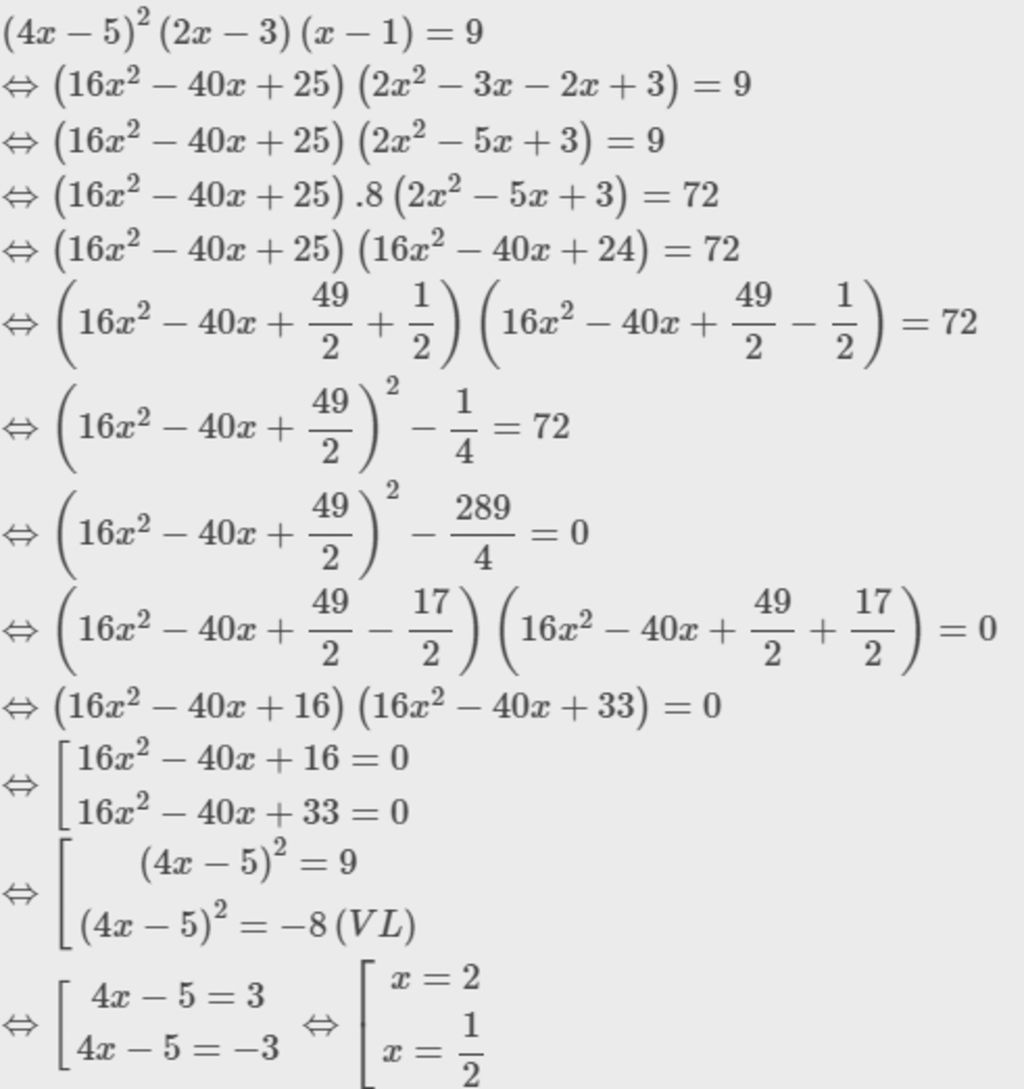
Hãy nhập câu hỏi của bạn vào đây, nếu là tài khoản VIP, bạn sẽ được ưu tiên trả lời.


a. \(\Leftrightarrow\left(2x-5\right)\left(2x+5\right)\left(x+1\right)\left(2x-9\right)=0\)
\(\Rightarrow\left[{}\begin{matrix}2x-5=0\\2x+5=0\\x+1=0\\2x-9=0\end{matrix}\right.\) \(\Rightarrow x=\)
b. \(\Leftrightarrow x^3+x+3x^2+3=0\)
\(\Leftrightarrow x\left(x^2+1\right)+3\left(x^2+1\right)=0\)
\(\Leftrightarrow\left(x+3\right)\left(x^2+1\right)=0\)
\(\Leftrightarrow\left[{}\begin{matrix}x+3=0\\x^2+1=0\left(vn\right)\end{matrix}\right.\)
c. \(\Leftrightarrow2x\left(3x-1\right)^2-\left(9x^2-1\right)=0\)
\(\Leftrightarrow\left(6x^2-2x\right)\left(3x-1\right)-\left(3x-1\right)\left(3x+1\right)=0\)
\(\Leftrightarrow\left(3x-1\right)\left(6x^2-5x-1\right)=0\)
\(\Leftrightarrow\left(3x-1\right)\left(x-1\right)\left(6x+1\right)=0\)
\(\Leftrightarrow\left[{}\begin{matrix}3x-1=0\\x-1=0\\6x+1=0\end{matrix}\right.\)
d.
\(\Leftrightarrow x^3-3x^2+2x-3x^2+9x-6=0\)
\(\Leftrightarrow x\left(x^2-3x+2\right)-3\left(x^2-3x+2\right)=0\)
\(\Leftrightarrow\left(x-3\right)\left(x^2-3x+2\right)=0\)
\(\Leftrightarrow\left(x-3\right)\left(x-1\right)\left(x-2\right)=0\)
\(\Leftrightarrow\left[{}\begin{matrix}x-3=0\\x-1=0\\x-2=0\end{matrix}\right.\)
e.
\(\Leftrightarrow x^3+2x^2+x+3x^2+6x+3=0\)
\(\Leftrightarrow x\left(x^2+2x+1\right)+3\left(x^2+2x+1\right)=0\)
\(\Leftrightarrow\left(x+3\right)\left(x^2+2x+1\right)=0\)
\(\Leftrightarrow\left(x+3\right)\left(x+1\right)^2=0\)
\(\Leftrightarrow\left[{}\begin{matrix}x+3=0\\x+1=0\end{matrix}\right.\)

b)\(9\left(x-2\right)^2-4\left(x-1\right)^2=\left(9x^2-36x+36\right)-\left(4x^2+8x-4\right)\)
\(=9x^2-36x+36-4x^2+8x-4\)
\(=5x^2-28x+32\)
\(=\left(x-5\right)\left(5x-8\right)\)
\(\hept{\begin{cases}x-5=0\\5x-8=0\end{cases}\Rightarrow}\hept{\begin{cases}x=5\\x=\frac{8}{5}=1\frac{3}{5}\end{cases}}\)
a) \(\left(x+1\right)^2-4\left(x^2-2x+1\right)=0\)
\(\left(x^2+2x+1\right)-\left(4x^2-8x+4\right)=0\)
\(-3x^2+10x-3=0\)
\(\left(3-x\right)\left(3x-1\right)=0\)
\(\hept{\begin{cases}3-x=0\\3x-1=0\end{cases}}\)
\(\hept{\begin{cases}x=3\\x=\frac{1}{3}\end{cases}}\)

\(\left(4x-5\right)\left(2x-3\right)\left(x-1\right)=9\)
\(\Leftrightarrow\left[{}\begin{matrix}4x-5=9\\2x-3=9\\x-1=9\end{matrix}\right.\)
\(\Leftrightarrow\left[{}\begin{matrix}x=3,5\\x=6\\x=10\end{matrix}\right.\)
Vậy \(x=\left\{3,5;6;10\right\}\)
d: Sửa đề: \(\left(4x-5\right)^2\cdot\left(2x-3\right)\left(x-1\right)=9\)

a: \(\Leftrightarrow\left(2x^2+x\right)^2-3\left(2x^2+x\right)-\left(2x^2+x\right)+3=0\)
\(\Leftrightarrow\left(2x^2+x\right)\left(2x^2+x-3\right)-\left(2x^2+x-3\right)=0\)
\(\Leftrightarrow\left(2x^2+x-3\right)\left(2x^2+x-1\right)=0\)
\(\Leftrightarrow\left(2x^2+3x-2x-3\right)\left(2x^2+2x-x-1\right)=0\)
\(\Leftrightarrow\left(2x+3\right)\left(x-1\right)\left(x+1\right)\left(2x-1\right)=0\)
hay \(x\in\left\{-\dfrac{3}{2};1;-1;\dfrac{1}{2}\right\}\)

a) \(3x^3-x+2=0\)
\(\Leftrightarrow3x^3+3x^2-3x^2-3x+2x+2=0\)
\(\Leftrightarrow3x^2\left(x+1\right)-3x\left(x+1\right)+2\left(x+1\right)=0\)
\(\Leftrightarrow\left(x+1\right)\left(3x^2-3x+2\right)=0\)
\(\Leftrightarrow\left[{}\begin{matrix}x=-1\\3x^2-3x^2+2=0\left(1\right)\end{matrix}\right.\)
Xét phương trình (1):
\(\Delta=9-24=-15< 0\)
\(\Rightarrow\) Phương trình (1) vô nghiệm.
Vậy phương trình đã cho có nghiệm \(x=-1\)
b) \(x^3-6x^2+10x-4=0\)
\(\Leftrightarrow x^3-2x^2-4x^2+8x^{ }+2x^{ }-4=0\)
\(\Leftrightarrow x^2\left(x-2\right)-4x\left(x-2\right)+2\left(x-4\right)=0\)
\(\Leftrightarrow\)\(\left(x-2\right)\left(x^2-4x+2\right)=0\)
\(\Leftrightarrow\left[{}\begin{matrix}x=2\\x^2-4x+2=0\left(2\right)\end{matrix}\right.\)
Xét phương trình (2):
\(\Delta'=4-2=2>0\)
\(\Rightarrow\) Phương trình (2) có 2 nghiệm phân biệt:
\(x_1=2+\sqrt{2}\)
\(x_2=2-\sqrt{2}\)
Vậy phương trình đã cho có ba nghiệm: \(x_1=2+\sqrt{2};x_2=2-\sqrt{2};x_3=2\)
c)\(3x^3+3x^2+3x+1=0\)
\(\Leftrightarrow\left(x+1\right)^3=0\)
\(\Leftrightarrow x=-1\)
Vậy phương trình đã cho có nghiệm \(x=-1\)


a). Đặt \(x^2=y\) \(\left(y\ge0\right)\) ta có ;
\(3y^2-12y+9=0\)
\(\Leftrightarrow y^2-4y+3=0\)
Nhận xét : \(a+b+c=1+\left(-4\right)+3=0\)
\(\Rightarrow y_1=1\) (TM \(y\ge0\))
\(y_2=\dfrac{3}{1}=3\)
Với \(y=y_1=1\Rightarrow x^2=1\Leftrightarrow x_1=1;x_2=-1\)
Với \(y=y_2=3\Rightarrow x^2=3\Leftrightarrow x_3=\sqrt{3};x_4=-\sqrt{3}\)
Vậy \(x_1=1;x_2=-1;x_3=\sqrt{3};x_4=-\sqrt{3}\) là các giá trị cần tìm
b) . Đặt \(x^2=y\) \(\left(y\ge0\right)\) ta có ;
\(2y^2+3y-2=0\)
\(\Delta_y=3^2-4\cdot2\cdot\left(-2\right)=9+16=25\) \(\left(\sqrt{\Delta}=5\right)\)
Vì \(\Delta>0\) nên pt có 2 nghiệm phân biệt
\(\Rightarrow\)\(y_1=\dfrac{-3+5}{2\cdot2}=\dfrac{1}{2}\) (TM \(y\ge0\) )
\(y_2=\dfrac{-3-5}{2\cdot2}=-2\) (KTM \(y\ge0\) )
Với \(y=y_1=\dfrac{1}{2}\Rightarrow x^2=\dfrac{1}{2}\Leftrightarrow x_1=\dfrac{1}{4};x_2=-\dfrac{1}{4}\)
Vậy \(x_1=\dfrac{1}{4};x_2=-\dfrac{1}{4}\) là các giá trị cần tìm
c) Đặt \(x^2=y\) \(\left(y\ge0\right)\) ta có ;
\(y^2+5y+1=0\)
\(\Delta_y=5^2-4\cdot1\cdot1=25-4=21\)
Vì \(\Delta>0\) nên pt có 2 nghiệm phân biệt
\(\Rightarrow y_1=\dfrac{-5+\sqrt{21}}{2\cdot1}=\dfrac{-5+\sqrt{21}}{2}\) (KTM \(y\ge0\))
\(y_2=\dfrac{-5-\sqrt{21}}{2\cdot1}=\dfrac{-5-\sqrt{21}}{2}\) (KTM \(y\ge0\))
Vậy pt đã cho vô nghiệm
phần b sai rồi
b, 2x4+3x2-2=0
Đặt x2=t (t>0) ta có
2t2 + 3t-2=0
\(\Delta\)=32-4.2.(-2)=25 \(\Rightarrow\)\(\sqrt{\Delta}\)=5
vì \(\Delta\)>0 nên PT có 2 nghiệm phân biệt
t1=\(\dfrac{-3+5}{2.2}=\dfrac{1}{2}\) (thỏa mãn)
t2=\(\dfrac{-3-5}{2.2}=-2\) (loại)
với t1=\(\dfrac{1}{2}\) => x2=\(\dfrac{1}{2}\) => x1=\(\pm\sqrt{\dfrac{1}{2}}\) =>x1=\(\pm\dfrac{\sqrt{2}}{2}\)
vậy PT đã cho có 2 nghiệm phân biệt là x1=\(-\dfrac{\sqrt{2}}{2}\) ;x2=\(\dfrac{\sqrt{2}}{2}\)

Câu c;d giải \(\Delta\)
Các câu còn lại là phương trình trùng phương, mình chỉ làm 1 câu thôi. Các câu sau tương tự
a/ \(x^4-2x^2-8=0\left(1\right)\)
Đặt: \(x^2=t\left(t\ge0\right)\)
\(\left(1\right)\Rightarrow t^2-2t-8=0\)
( a = 1; b = -2; c = -8 )
\(\Delta=b^2-4ac\)
\(=\left(-2\right)^2-4.1.\left(-8\right)\)
\(=36>0\)
\(\sqrt{\Delta}=\sqrt{36}=6\)
Pt có 2 nghiệm phân biệt:
\(t_1=\frac{-b-\sqrt{\Delta}}{2a}=\frac{2-6}{2.1}=-2\left(l\right)\)
\(t_2=\frac{-b+\sqrt{\Delta}}{2a}=\frac{2+6}{2.1}=4\left(n\right)\Rightarrow x^2=4\Leftrightarrow x=2hayx=-2\)
Vậy: S = {-2;2}

a: \(\Leftrightarrow10x^2+17x+3-4x+17=0\)
\(\Leftrightarrow10x^2+13x+20=0\)
\(\text{Δ}=13^2-4\cdot10\cdot20=-631< 0\)
Do đó: Phương trình vô nghiệm
b: \(\Leftrightarrow x^2+7x-3=x^2-x-1\)
=>8x=2
hay x=1/4
c: \(\Leftrightarrow2x^2-5x-3=x^2-1+3=x^2+2\)
\(\Leftrightarrow x^2-5x-5=0\)
\(\text{Δ}=\left(-5\right)^2-4\cdot1\cdot\left(-5\right)=25+20=45>0\)
Do đó: Phương trình có hai nghiệm phân biệt là:
\(\left\{{}\begin{matrix}x_1=\dfrac{5-3\sqrt{5}}{2}\\x_2=\dfrac{5+3\sqrt{5}}{2}\end{matrix}\right.\)
a:
ĐKXĐ: \(x^2+3x>=0\)
=>x(x+3)>=0
=>\(\left[{}\begin{matrix}x>=0\\x< =-3\end{matrix}\right.\)
\(\sqrt{16}-\sqrt{x^2+3x}=0\)
=>\(\sqrt{x^2+3x}=\sqrt{16}\)
=>x^2+3x=16
=>x^2+3x-16=0
\(\text{Δ}=3^2-4\cdot1\cdot\left(-16\right)=9+64=73>0\)
Do đó: Phương trình có 2 nghiệm phân biệt là:
\(\left\{{}\begin{matrix}x_1=\dfrac{-3-\sqrt{73}}{2}\\x_2=\dfrac{-3+\sqrt{73}}{2}\end{matrix}\right.\)
b:
ĐKXĐ: \(x\in R\)
\(3x-1-\sqrt{4x^2-12x+9}=0\)
=>\(\sqrt{\left(2x-3\right)^2}=3x-1\)
=>\(\left\{{}\begin{matrix}3x-1>=0\\\left(3x-1\right)^2=\left(2x-3\right)^2\end{matrix}\right.\)
=>\(\left\{{}\begin{matrix}x>=\dfrac{1}{3}\\\left(3x-1-2x+3\right)\left(3x-1+2x-3\right)=0\end{matrix}\right.\)
=>\(\left\{{}\begin{matrix}x>=\dfrac{1}{3}\\\left(x+2\right)\left(5x-4\right)=0\end{matrix}\right.\Leftrightarrow\left[{}\begin{matrix}x=-2\left(loại\right)\\x=\dfrac{4}{5}\left(nhận\right)\end{matrix}\right.\)
c:
ĐKXĐ: \(\left\{{}\begin{matrix}x^2-6x+8>=0\\2x^2-10x+11>=0\end{matrix}\right.\)
=>\(\left\{{}\begin{matrix}\left[{}\begin{matrix}x>=4\\x< =2\end{matrix}\right.\\\left[{}\begin{matrix}x< =\dfrac{5-\sqrt{3}}{2}\\x>=\dfrac{5+\sqrt{3}}{2}\end{matrix}\right.\end{matrix}\right.\)
=>\(\left[{}\begin{matrix}x< =\dfrac{5-\sqrt{3}}{2}\\x>=4\end{matrix}\right.\)
\(\sqrt{2x^2-10x+11}=\sqrt{x^2-6x+8}\)
\(\Leftrightarrow2x^2-10x+11=x^2-6x+8\)
=>\(x^2-4x+3=0\)
=>(x-1)(x-3)=0
=>x=3(loại) hoặc x=1(nhận)